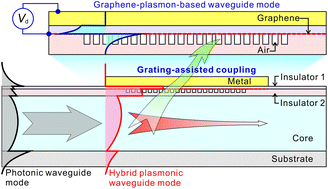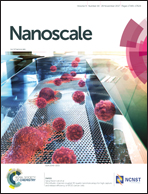Mid-infrared subwavelength modulator based on grating-assisted coupling of a hybrid plasmonic waveguide mode to a graphene plasmon†
Abstract
This work reports a mid-infrared modulator based on a hybrid plasmonic waveguide with graphene on a grating in its slot region. The modulator utilizes a graphene plasmon for electro-optic tuning in a more practical and effective way than graphene-plasmon-based waveguide devices studied up to now. The hybrid plasmonic waveguide can be easily and efficiently integrated with input and output photonic waveguides. It supports a hybrid plasmonic waveguide mode and a graphene-plasmon-based waveguide mode. Grating-assisted coupling of the former to the latter in it is demonstrated to work successfully even though the two modes have significantly different propagation constants and losses. Theoretical investigation of the modulator shows that the coupling via the grating of length 5.92 μm generates a deep rejection band at a wavelength of 8.014 μm in the transmission spectrum of the output photonic waveguide of the modulator. With the graphene chemical potential tuned between 0.6 eV and 0.65 eV, the transmission at the wavelength is modulated between −27 dB and −1.8 dB. The subwavelength modulator, which may have a large bandwidth and small energy consumption, is expected to play a key role in free-space communications and sensing requiring mid-infrared integrated photonics.



 Please wait while we load your content...
Please wait while we load your content...